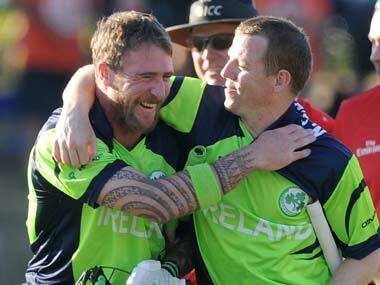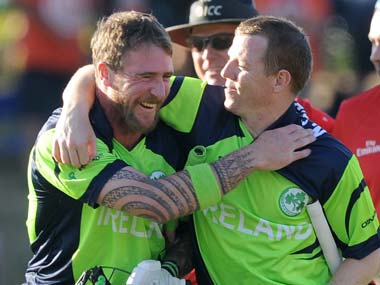When it comes to the ICC World Cup format, commonsense has gone out the window. On the one hand, David Richardson, the ICC ceo, believes that the 2015 tournament -with 10 Full Members and four Associate nations will be “
bigger and better than ever
”, He also thinks it is better to have only 10 teams taking part in the 2019 edition of the tournament. It goes well with the muddled message of a “global game” that is being shrunk for the narrow interests of a few. While every other major sport in the world is trying to expand by providing opportunities for newer countries to take part in their flagship events, Cricket seems keen on turning the clock back from globalisation to global isolationism. [caption id=“attachment_2115579” align=“alignleft” width=“380”]
 Ireland chased down over 300 to beat West Indies. Getty[/caption] What exactly is so egregiously wrong with the format of the 2011 and 2015 World cups that the ICC felt the urge to return to the 1992 format? “I am not saying there is anything specifically wrong with it,” Richardson said. “But there is the criticism that you actually have to play really badly to not qualify for the QF. When you have got a competition with 10 teams, where everybody plays everybody, every single one of those matches stays important throughout the duration of the tournament. People often say that the best format of ICC WC was the 1992 WC. That was the reason to revert to the 1992 format.” There are some things fundamentally wrong with the inherent assumptions in that statement. The ICC Chief Executive believes that the Associate nations won’t muster much of a challenge to the Full Member nations, and so, the top eight teams will have smooth sailing in to the knockout stages. He has clearly not been paying attention to the current World Cup and is therefore hopelessly unaware of the strong progress the Associate nations have made in the last few years even with severely limited opportunities. It’s like asking someone to climb a mountain with their one hand tied behind their back, in the dark with no torch, and just to add to some comedic value, someone tied their shoelaces together too. Associate nations not only have climbed that mountain but are desperate to reach higher but the ICC is telling them to pack up the expedition and go home. If Richardson and the ICC were keen on having a World Cup tournament where the matches are exciting and unpredictable, they needn’t look further than some of the matches in this World Cup that featured Associate nations. Ireland whipped West Indies; Scotland almost turned the tables on tournament favourites New Zealand; Afghanistan scared the living hell out of Sri Lanka, and U.A.E. just failed to close the deal against Zimbabwe. In contrast, many of the marquee matches between Full Member nations have been decidedly one-sided. When the Associate nations bring so much to the table, why go out of your way to limit the number of teams that can take part in the World Cup? Richardson doesn’t see the move to 10 teams as “denying the Associate members the chance” but as “giving them more opportunities.” The 2019 tourney will automatically include the top 8 teams in the ICC rankings by the qualification date, and two more who come through a qualifying tournament held between six teams. Richardson believes that allowing the top eight direct entry to the tournament would mean that Associate nations could qualify directly to the CWC instead of going through the Qualifying tournament to be held in Bangladesh in 2018. However, here is the catch: The Associate nations – all of whom are outside the top 10 in the current
ICC ODI rankings
– cannot make that climb up the charts without regularly playing higher ranked teams, and defeating them. Richardson has already said it will be “
difficult to guarantee
” regular matches for the Associate nations against the Full Member nations. At the conclusion of 2011 World Cup, ICC, in their infinite wisdom, declared that they were going to limit the number of teams in the 2015 World Cup to 10. After severe backlash from the fans and the media, they took back their boneheaded decision. They have tried to pull the same trick again and as Richardson says, there is even less chance this time around for them to call mulligan on it. “I’ll never say never but I know the venues and everything [are set], and a lot of the work has been done already to move towards the 10-team tournament in 2019.” But that hasn’t discouraged cricket watchers from trying to cause the change. There is an
online petition
started by a concerned cricket fan to generate sufficient public pressure on the ICC – for what it’s worth – to do the right thing. It already has garnered more than 2,300 signatories. In their “Vision of Success,” ICC state that “As a leading global sport, cricket will captivate and inspire people of every age, gender, background and ability while building bridges between continents, countries and communities.” However, all their actions leading to the 2019 World Cup indicate their true vision of success is not building bridges, but burning them.
Ireland chased down over 300 to beat West Indies. Getty[/caption] What exactly is so egregiously wrong with the format of the 2011 and 2015 World cups that the ICC felt the urge to return to the 1992 format? “I am not saying there is anything specifically wrong with it,” Richardson said. “But there is the criticism that you actually have to play really badly to not qualify for the QF. When you have got a competition with 10 teams, where everybody plays everybody, every single one of those matches stays important throughout the duration of the tournament. People often say that the best format of ICC WC was the 1992 WC. That was the reason to revert to the 1992 format.” There are some things fundamentally wrong with the inherent assumptions in that statement. The ICC Chief Executive believes that the Associate nations won’t muster much of a challenge to the Full Member nations, and so, the top eight teams will have smooth sailing in to the knockout stages. He has clearly not been paying attention to the current World Cup and is therefore hopelessly unaware of the strong progress the Associate nations have made in the last few years even with severely limited opportunities. It’s like asking someone to climb a mountain with their one hand tied behind their back, in the dark with no torch, and just to add to some comedic value, someone tied their shoelaces together too. Associate nations not only have climbed that mountain but are desperate to reach higher but the ICC is telling them to pack up the expedition and go home. If Richardson and the ICC were keen on having a World Cup tournament where the matches are exciting and unpredictable, they needn’t look further than some of the matches in this World Cup that featured Associate nations. Ireland whipped West Indies; Scotland almost turned the tables on tournament favourites New Zealand; Afghanistan scared the living hell out of Sri Lanka, and U.A.E. just failed to close the deal against Zimbabwe. In contrast, many of the marquee matches between Full Member nations have been decidedly one-sided. When the Associate nations bring so much to the table, why go out of your way to limit the number of teams that can take part in the World Cup? Richardson doesn’t see the move to 10 teams as “denying the Associate members the chance” but as “giving them more opportunities.” The 2019 tourney will automatically include the top 8 teams in the ICC rankings by the qualification date, and two more who come through a qualifying tournament held between six teams. Richardson believes that allowing the top eight direct entry to the tournament would mean that Associate nations could qualify directly to the CWC instead of going through the Qualifying tournament to be held in Bangladesh in 2018. However, here is the catch: The Associate nations – all of whom are outside the top 10 in the current
ICC ODI rankings
– cannot make that climb up the charts without regularly playing higher ranked teams, and defeating them. Richardson has already said it will be “
difficult to guarantee
” regular matches for the Associate nations against the Full Member nations. At the conclusion of 2011 World Cup, ICC, in their infinite wisdom, declared that they were going to limit the number of teams in the 2015 World Cup to 10. After severe backlash from the fans and the media, they took back their boneheaded decision. They have tried to pull the same trick again and as Richardson says, there is even less chance this time around for them to call mulligan on it. “I’ll never say never but I know the venues and everything [are set], and a lot of the work has been done already to move towards the 10-team tournament in 2019.” But that hasn’t discouraged cricket watchers from trying to cause the change. There is an
online petition
started by a concerned cricket fan to generate sufficient public pressure on the ICC – for what it’s worth – to do the right thing. It already has garnered more than 2,300 signatories. In their “Vision of Success,” ICC state that “As a leading global sport, cricket will captivate and inspire people of every age, gender, background and ability while building bridges between continents, countries and communities.” However, all their actions leading to the 2019 World Cup indicate their true vision of success is not building bridges, but burning them.
Subash is a cricket blogger and podcaster based in the US. His introduction to Cricket began with enduring sledges from his elder brothers during their many backyard cricket sessions. He supports Chennai Super Kings in the IPL. He blogs at http://thecricketcouch.com and can be found on Twitter @thecricketcouch.
)